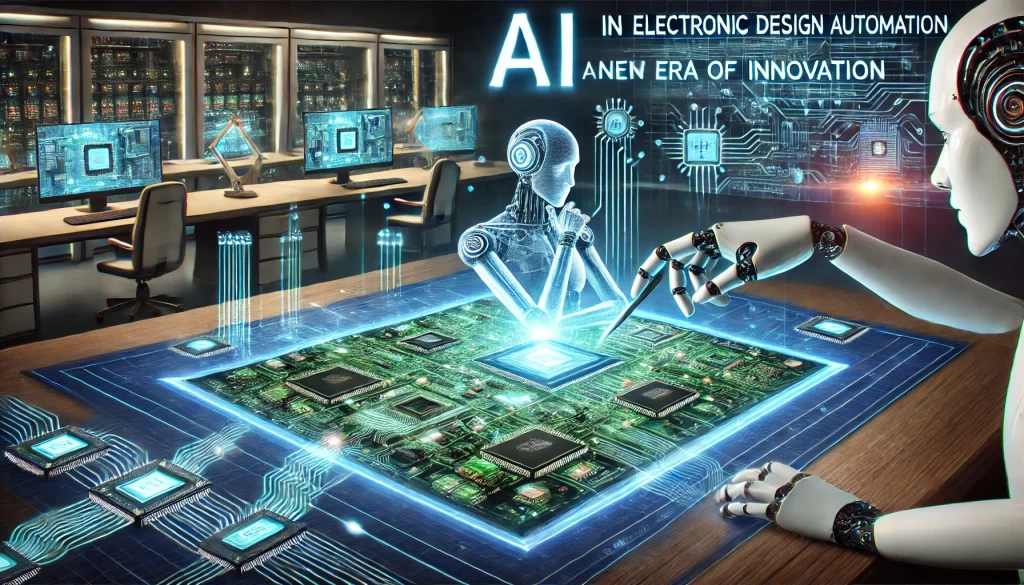As technology progresses, the complexity of electronic systems continues to grow exponentially. Designing these intricate systems demands tools that not only manage complexity but also optimize performance, power, and cost. Enter AI in Electronic Design Automation (EDA), a transformative force redefining how electronic circuits and systems are designed.

What is Electronic Design Automation (EDA)?
Electronic Design Automation refers to the set of software tools used to design, analyze, and verify electronic systems. EDA is essential for creating everything from microprocessors to printed circuit boards (PCBs). Traditional EDA tools rely heavily on manual inputs, complex algorithms, and iterative processes. With AI integration, these tools are becoming smarter, faster, and more efficient.
The electronic design automation market is consolidated, with major companies such as Cadence Design Systems, Inc., Siemens, Synopsys, Inc., ANSYS, Inc., and Keysight Technologies, Inc., and numerous small- and medium-sized enterprises. Almost all players offer a wide range of products, including computer-aided engineering (CAE), IC physical design & verification, PCB & MCM, semiconductor IPs, as well as services. These solutions are widely used in the automotive, healthcare, aerospace & defense, telecom and data center, consumer electronics industries, and the industrial sector.
The Role of AI in EDA
Artificial Intelligence brings the power of machine learning, deep learning, and data-driven optimization to EDA. AI algorithms process vast amounts of data from previous designs and simulations to predict outcomes, optimize designs, and automate repetitive tasks.
- Automation of Design Processes:
- AI automates routine tasks like schematic generation, component placement, and wiring, saving time and reducing errors.
- Design Space Exploration:
- AI models can explore multiple design configurations quickly, identifying optimal solutions for speed, power, and area.
- Predictive Analysis:
- Machine learning models predict potential design issues, such as signal integrity problems or power inefficiencies, during early design stages.
- Optimization:
- AI improves design efficiency by fine-tuning parameters for performance, power consumption, and manufacturing cost.
Applications of AI in EDA
- Chip Design:
- AI accelerates the creation of integrated circuits (ICs) by automating the layout, logic synthesis, and verification processes.
- Tools powered by AI ensure faster and more accurate placement and routing, critical for advanced chips like those used in AI accelerators and 5G technology.
- Verification and Testing:
- AI enhances simulation processes by predicting and testing edge cases more effectively than traditional tools.
- Machine learning reduces the time required for functional verification, ensuring faster time-to-market.
- PCB Design:
- AI assists in optimizing PCB layouts by automating trace routing and component placement for reduced interference and improved signal quality.
- AI models analyze thermal behavior, helping to design heat-efficient boards.
- Manufacturability and Yield Analysis:
- AI algorithms identify potential manufacturing defects before production, reducing waste and improving yield.
- These tools simulate real-world conditions to ensure robustness and reliability.
- Power and Performance Optimization:
- AI-driven tools analyze power usage patterns and suggest design changes to minimize energy consumption while maintaining performance.
- Custom Hardware Design:
- AI facilitates the development of custom hardware for specialized tasks, such as GPUs for gaming or TPUs for AI applications.
Benefits of AI in EDA
- Speed:
- AI accelerates the design cycle, enabling faster delivery of new electronic products.
- Accuracy:
- By learning from previous designs, AI minimizes errors and improves design reliability.
- Cost Efficiency:
- Reduced design iterations and faster prototyping lower overall development costs.
- Innovation:
- AI opens new possibilities in design, enabling more complex and efficient systems that were previously unfeasible.
Challenges and Future Directions
- Data Dependency:
- AI models require large amounts of high-quality data to be effective. Ensuring data availability and accuracy is crucial.
- Integration Complexity:
- Seamlessly integrating AI into existing EDA workflows can be challenging.
- Interpretability:
- AI’s decision-making processes can sometimes be opaque, making it difficult for designers to trust its recommendations fully.
Looking ahead, advancements in AI algorithms and computing power will drive further innovation in EDA. Technologies like quantum computing, neuromorphic engineering, and edge AI will push the boundaries of what AI-enhanced EDA can achieve.
AI in Electronic Design Automation is not just a technological upgrade; it’s a paradigm shift. By merging AI with traditional EDA tools, designers can tackle the growing complexity of modern electronic systems with unprecedented efficiency and creativity. As the demand for smarter, smaller, and more efficient electronics grows, AI-driven EDA will be at the forefront, enabling the next wave of technological breakthroughs.